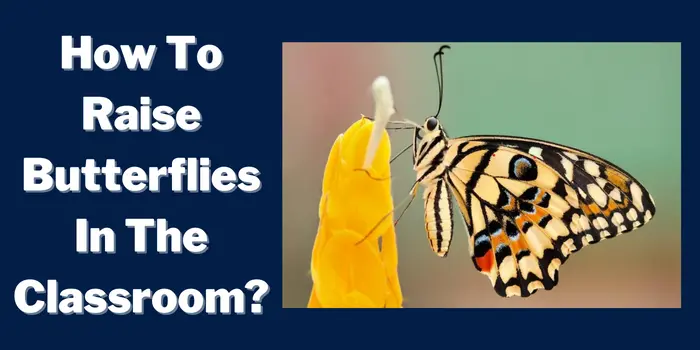
Raising butterflies in the classroom is one of the best experimental experiences for young students. Seeing it grow from being a caterpillar into a butterfly and setting it off will always be the highlight of the school session for students. Thankfully, butterflies are very easy to raise, even in the classroom. This article discusses tips for managing the classroom while raising a butterfly and observing its life cycle.
Prepare the caterpillar cups
This is the first step to take, and it’s necessary to do this before the arrival of the caterpillar. Get your caterpillar cups, large safety pins, and paper towels.
On arrival of the caterpillars, you must fill the cups with food. Ensure that this kit includes a cup with a sizeable mashed mallow plant. One of the best ways to prepare the cup is to add a spoonful of food and push it with another cup so that it goes down to the bottom.
Firmly press down to ensure no air holes or spaces between the cup and the food. It’s possible that the caterpillar can find its way into those holes and get stuck in them.
The next step is to cut pieces of paper towels into squares big enough to cover the cup’s opening. A 1.5-inch square may be good enough.
Get a pencil, pipe cleaner, or paint brush, and use it to brush a caterpillar gently into each of the prepared cups. Cover the top of the cup with the paper towel square and put on the lid. At some point, the caterpillars attach to the paper towel to form their chrysalis. They’ll attach themselves to the cup’s lid if the paper towel is absent.
After the caterpillar has formed a chrysalis, move it into its habitat. This is where you’ll need the paper towel. It’s easier to use safety pins to carefully pin the towel against the pavilion’s sides than to push the safety pin through a plastic lid while trying not to disturb the chrysalis.
Managing your caterpillar with other students
This is a necessary part to note. You must write down your initials/name on the lid as a student. If you’re sitting down in a group, you should ensure that your caterpillar is kept in a basket together with others in the same group.
Place the basket on top of your classroom’s filing cabinet or somewhere it’s not exposed and within everyone’s reach until you observe the activities of the caterpillar and its growth. Sometimes, you may have to observe the caterpillar cups and see what’s happening with them. Make sure you do this daily and keep records of the changes you observe in an observation journal. You’ll need small hand lenses for these observations, so you should get one.
You should also try to draw what you observe in the cup and label them. This is a good way to examine your understanding of the life cycle of a butterfly, and you also get to use your science vocabulary.
Learn lessons on adaptations, metamorphosis, and pollination
There are several biology lessons to learn from raising butterflies in the classroom. Chief of these is adaptations, metamorphosis, and pollination. Several stages of a butterfly’s life cycle include its metamorphosis from caterpillar to butterfly. It also has to grow in an environment different from its natural habitat, which teaches the lesson about adaptations. You also get to learn about their involvement in pollination. There’s always more to learn, and you can get all the academic help you need from assignment help online by simply asking.
The butterfly experiments
It would help if you first learned to handle your caterpillar with care. During this experiment, you’ll learn about the adaptations of caterpillars and butterflies and the changes in the chrysalis. You also explore the compound eye of the butterfly using kaleidoscopes. You’ll find that butterflies can see color, shapes, and movement through the thousands of lenses within the compound eyes.
You can also do a small pollination experiment using cheese powder, mac, and juice boxes to simulate butterflies and their transfer of pollens.
How To Take Care Of Butterflies?
At the butterfly’s emergence, put orange or watermelon slices and the lid of a jar under its habitat. Cover the lid’s bottom with water and add as much as is needed. You can also put some cotton balls or a sponge in the lid. If the water is too much, the butterfly might frown. Also, because the butterfly is newly hatched, its wings aren’t strong enough to fly out of the lid if it falls in.
The wings are usually soft and folded at the start. So, it can’t fly. After about 2 hours, the wings become completely hard and grow full-size. Ensure that you don’t touch the butterfly or bump into the habitat at this point. You might see a red blood-like liquid from its tail or on the pavilion’s sides. It’s called Meconium and is a waste product from the metamorphosis process.
Releasing the butterfly
After spending a few days observing the butterfly, you should release it. It’s safe to let it go when the outdoor temperatures are at 55 degrees. Take the butterfly’s habitat outdoors, and open the top carefully. You may need to guide it out. After releasing it, you might see it within that area for a few days before it probably finds its way.
Conclusion
The butterfly classroom experience is one part of your academic career that you are unlikely to forget. It’s a wonderful experience that will always stick with you and is a highlight you can always pass on to others. Apart from the practical aspect of raising the butterfly and the experience, there are also many biological concepts you get to understand better due to this experiment. Ensure you don’t get too attached to the butterfly, so it doesn’t become too difficult to let go when it’s time to release it. You shouldn’t hold it back once it grows fully.






